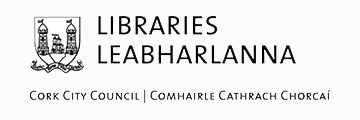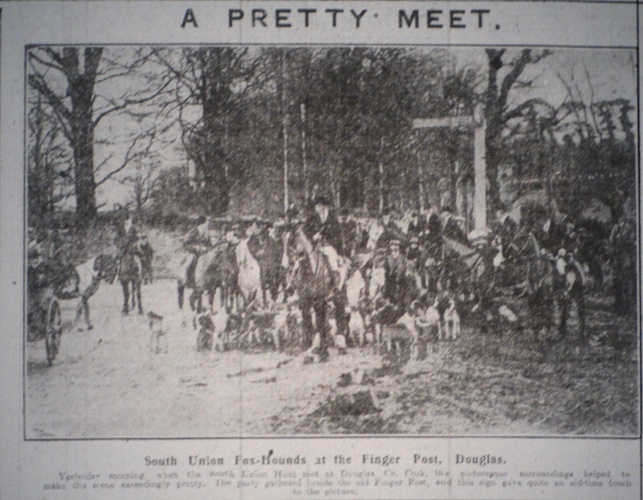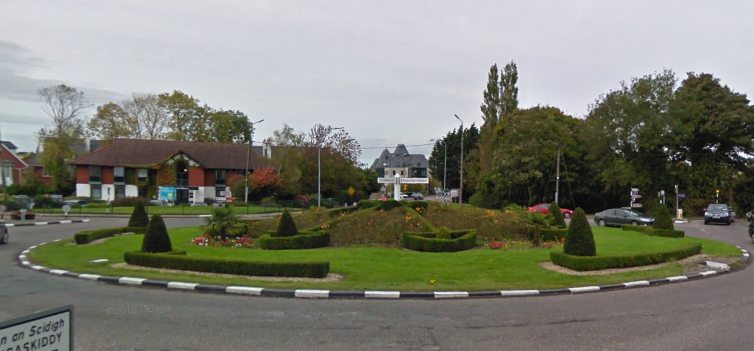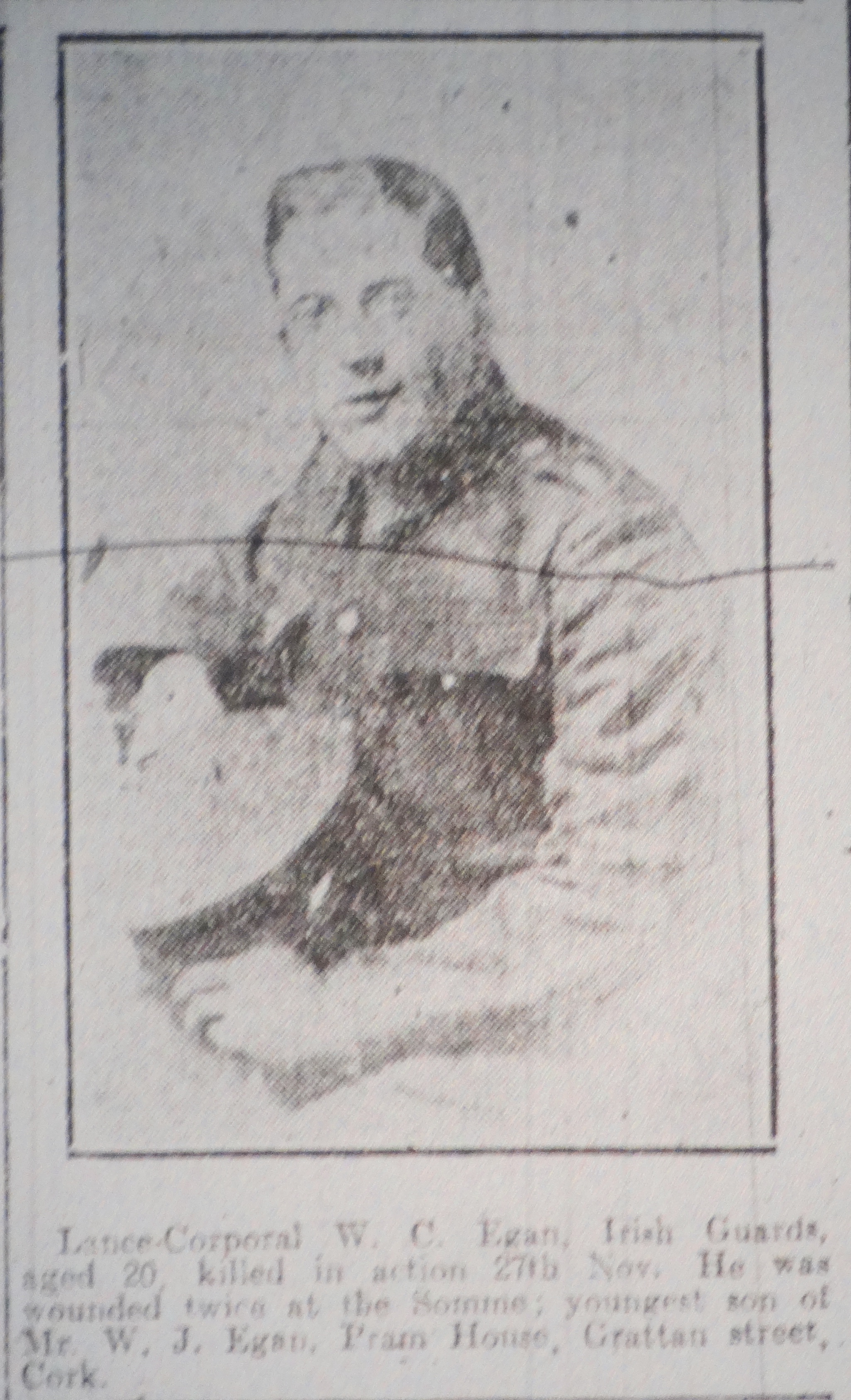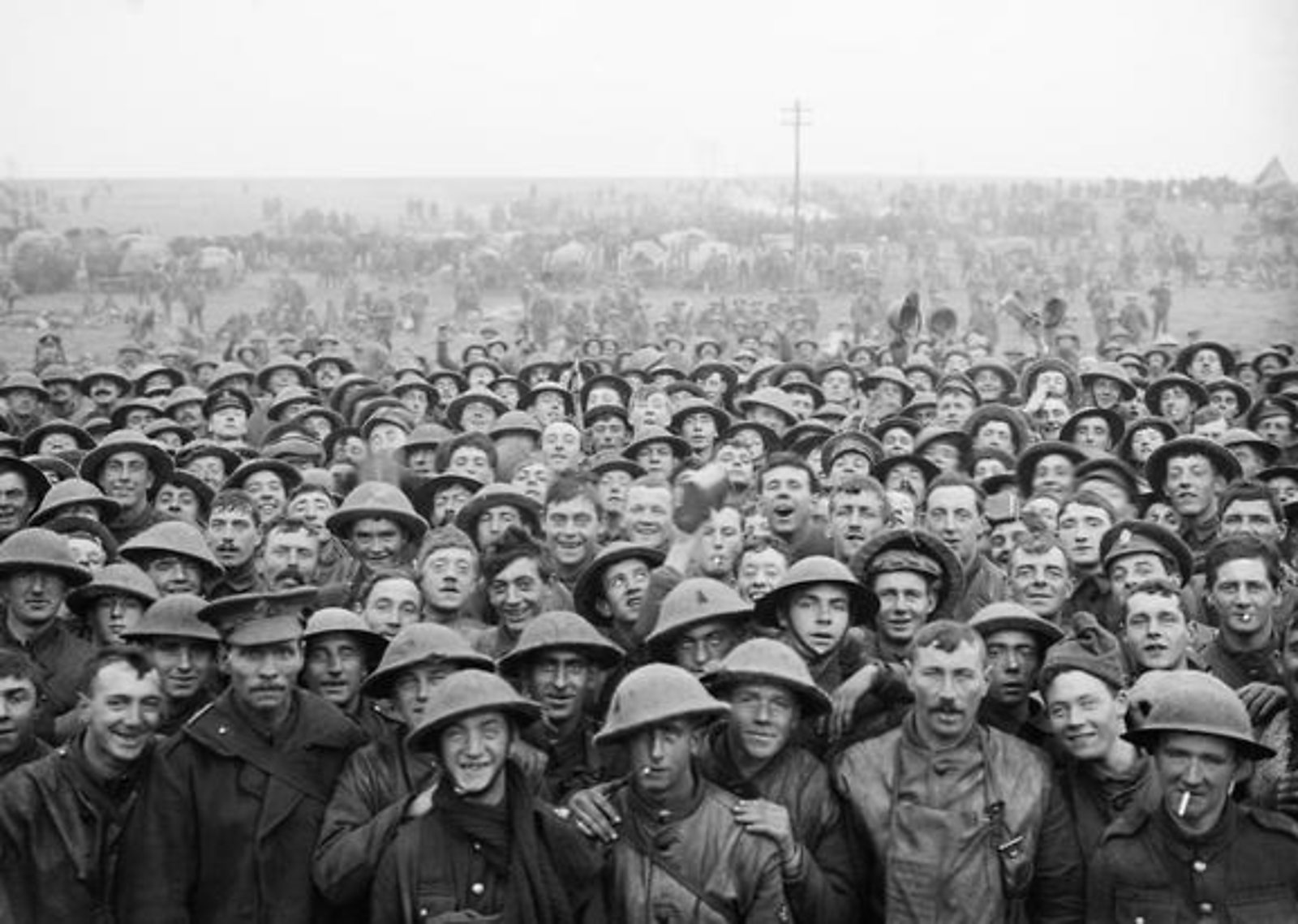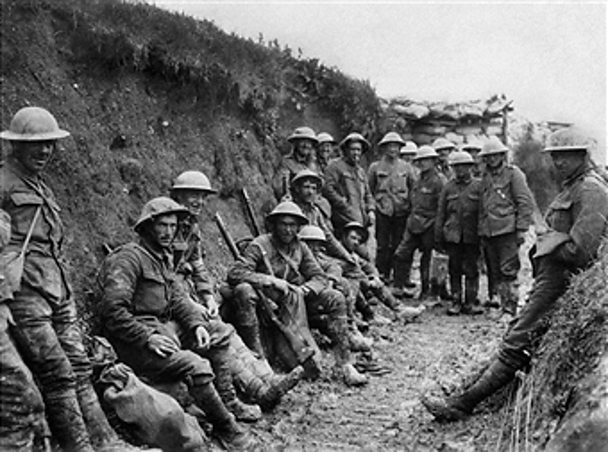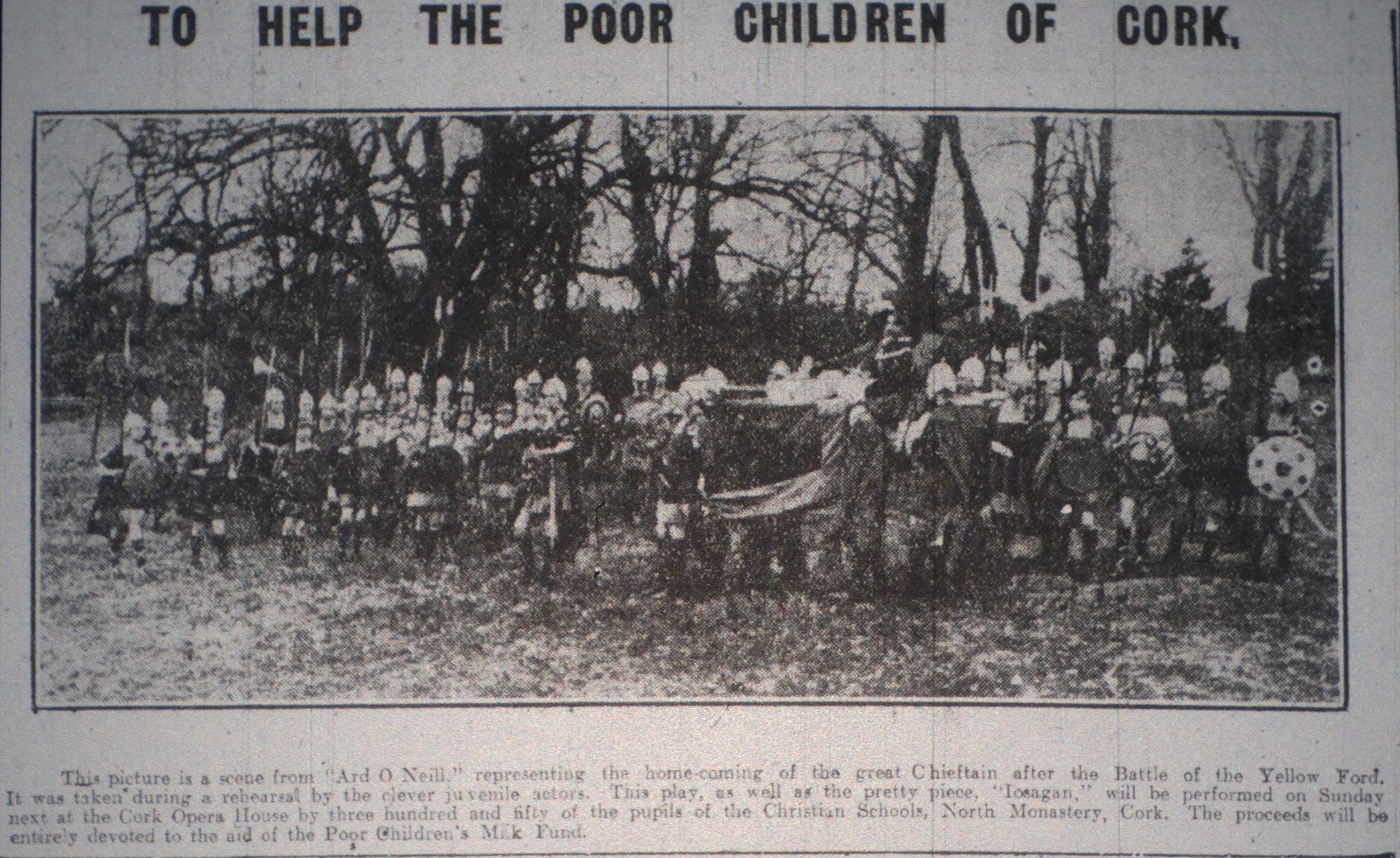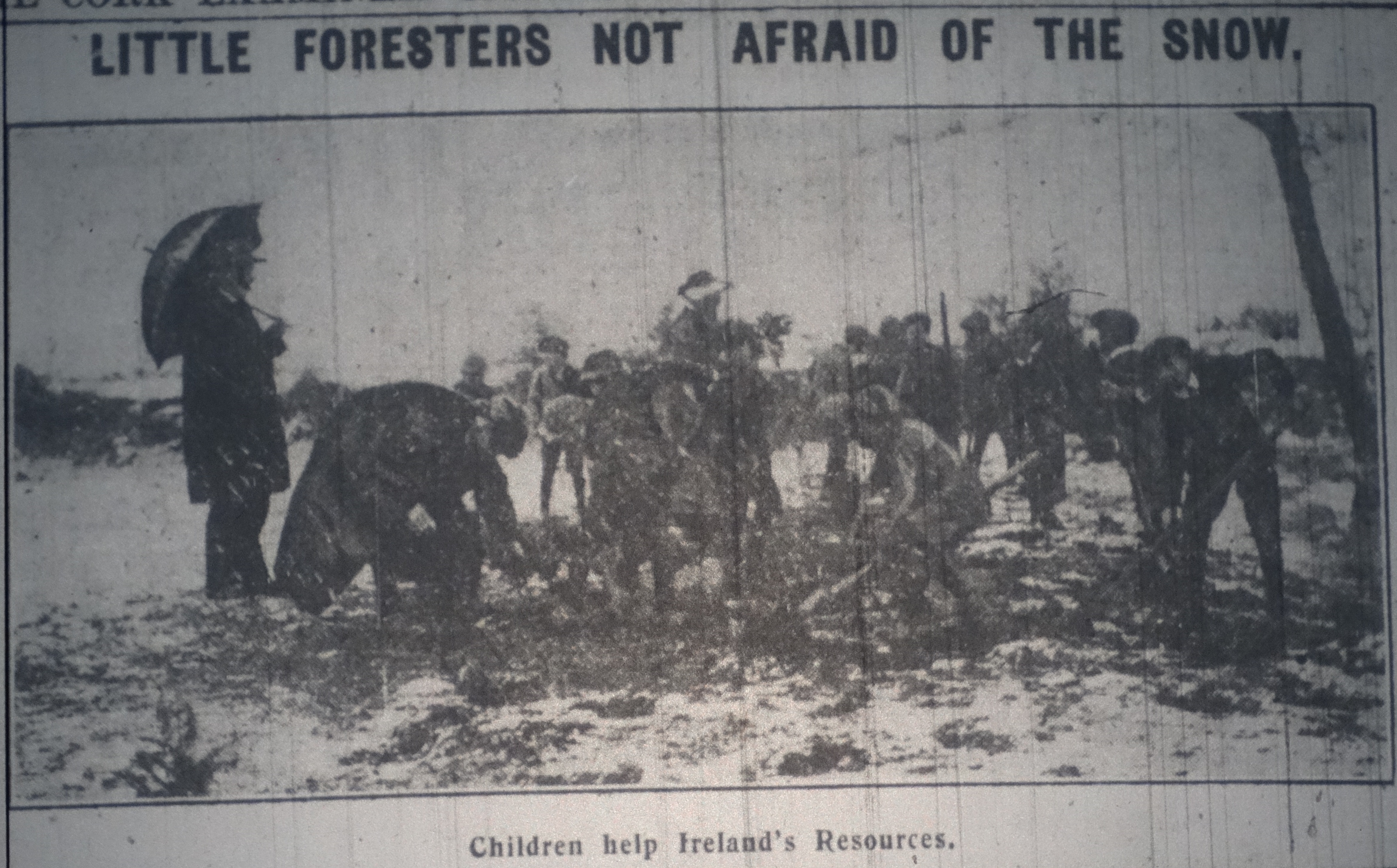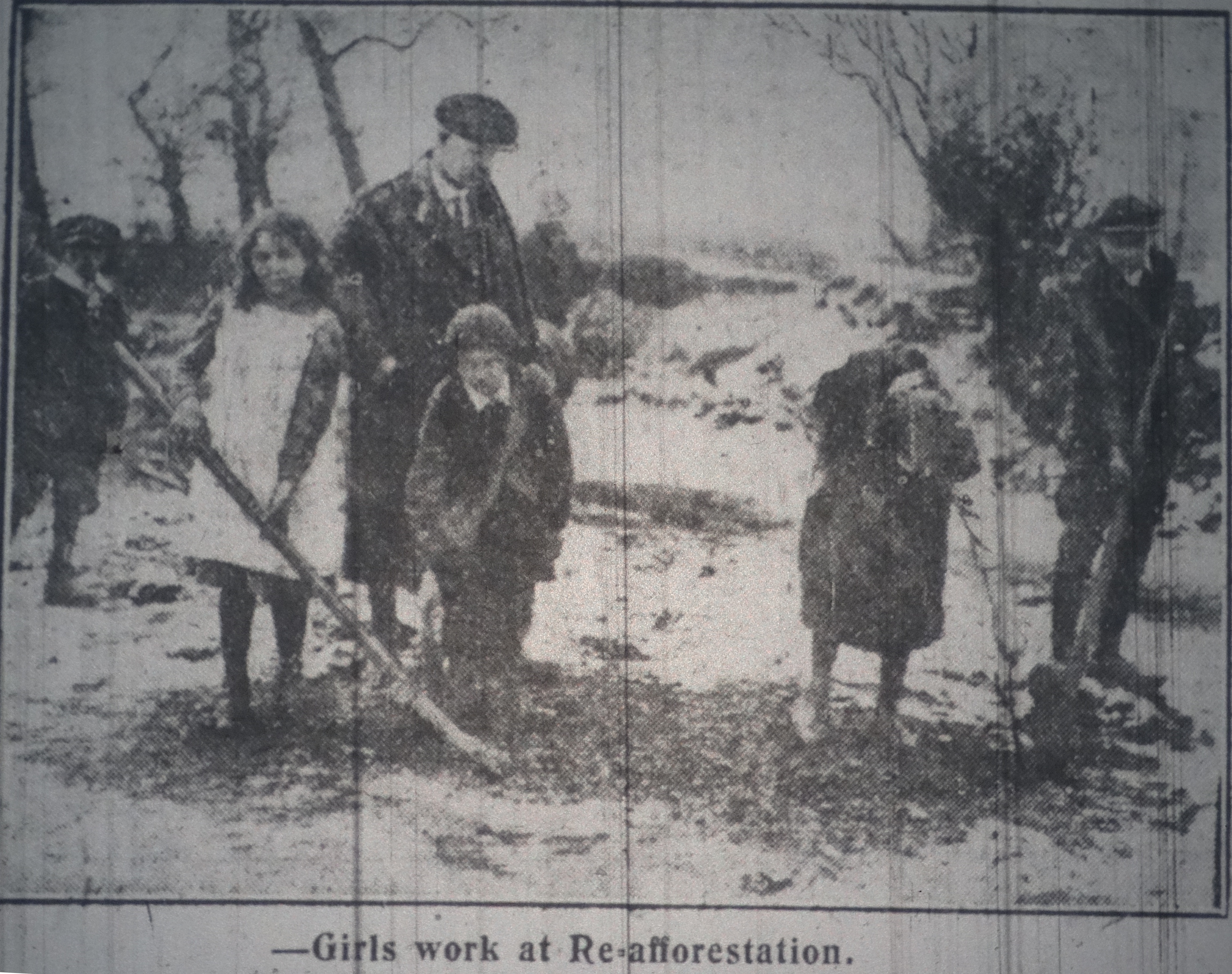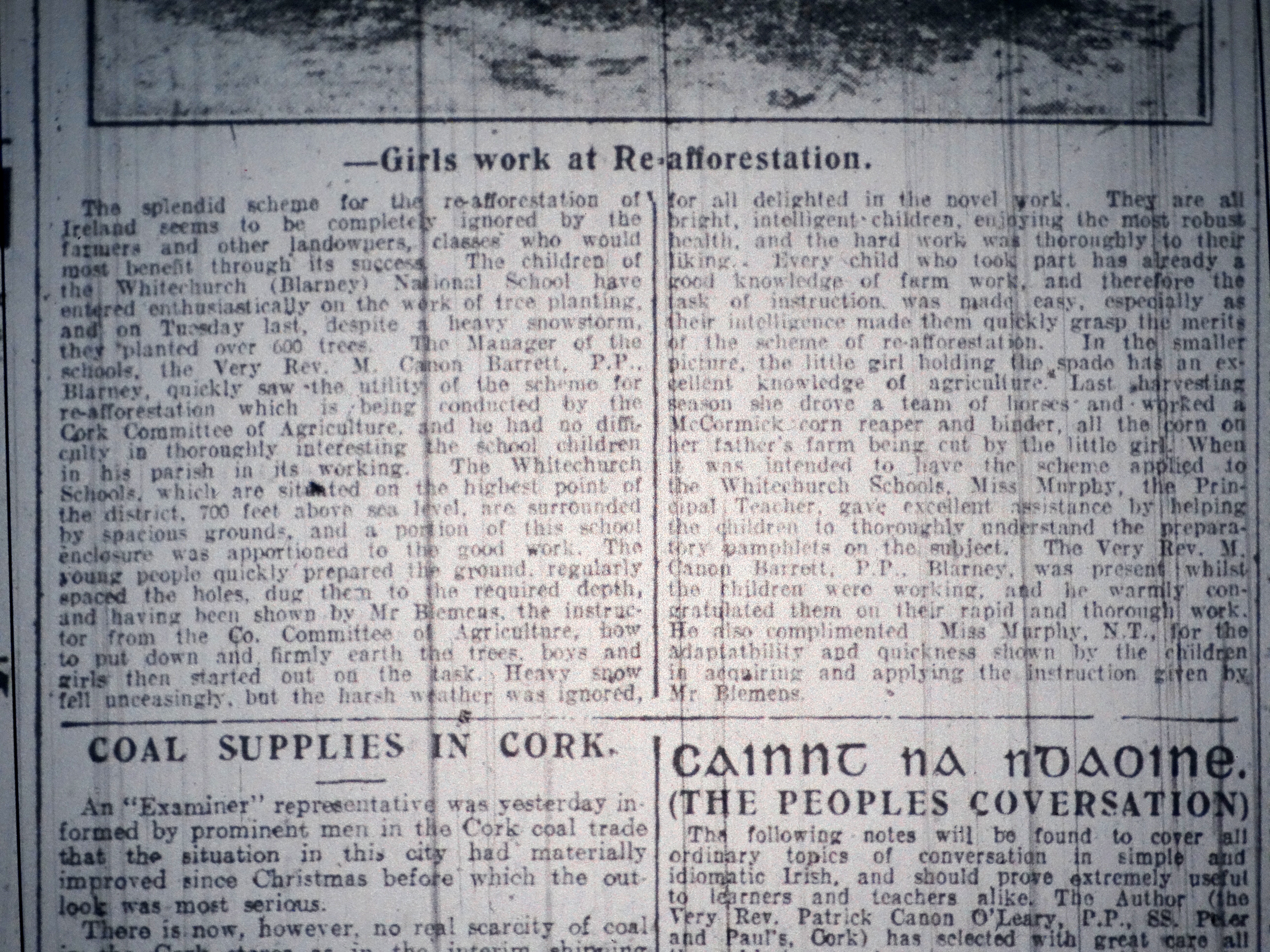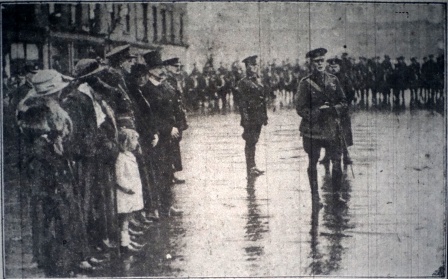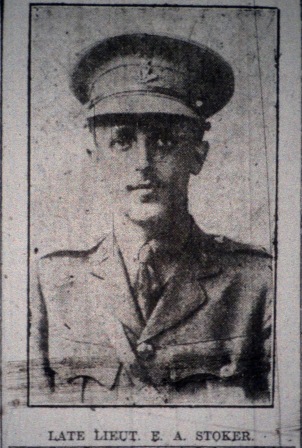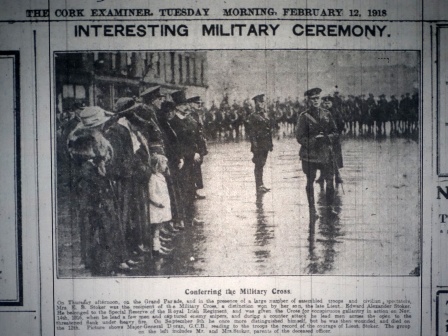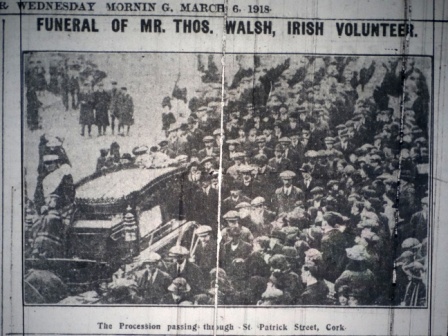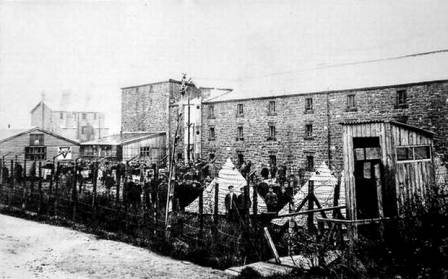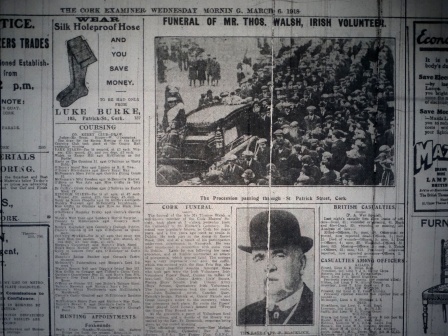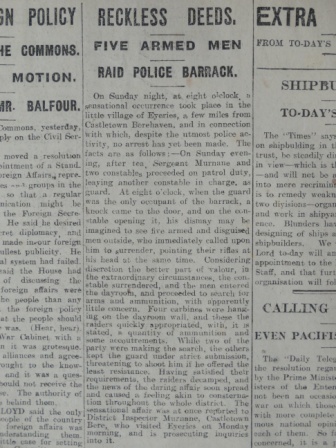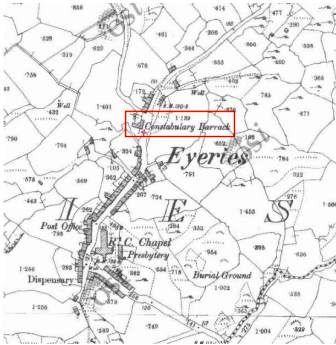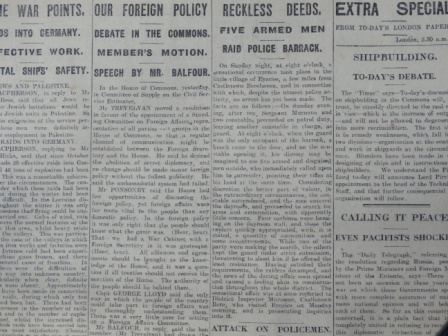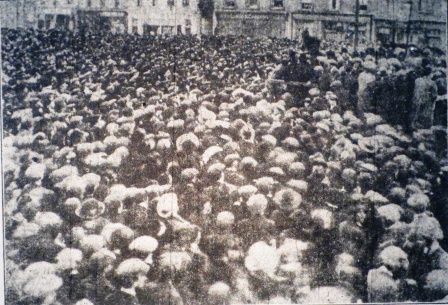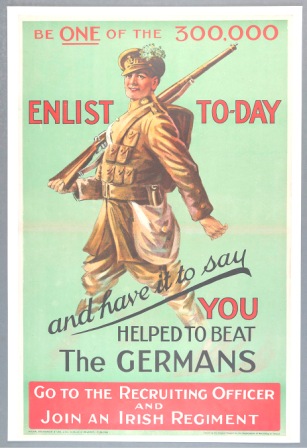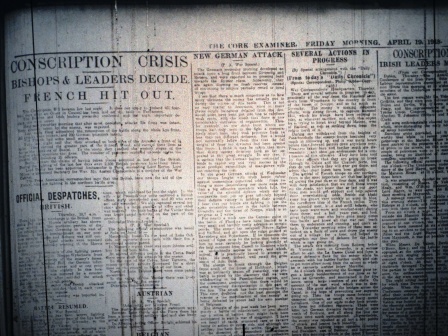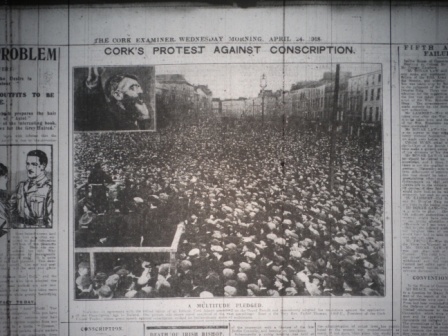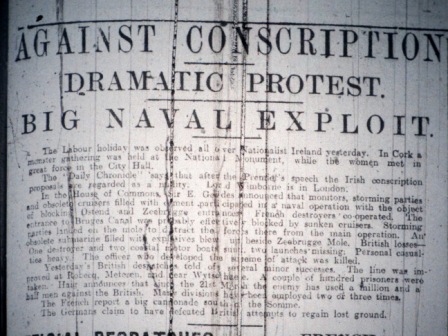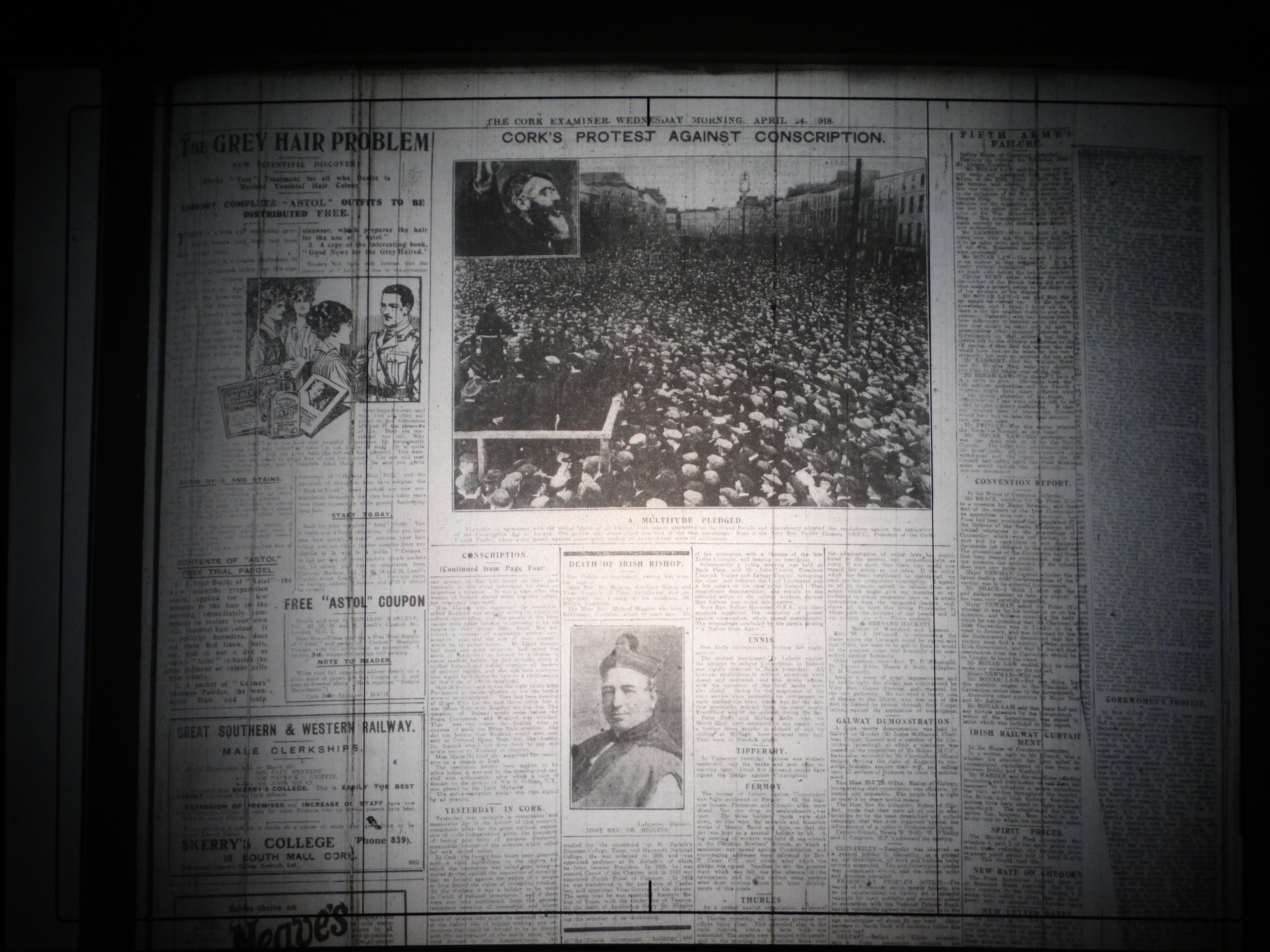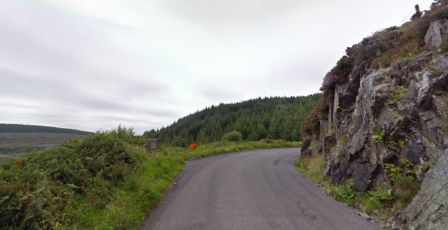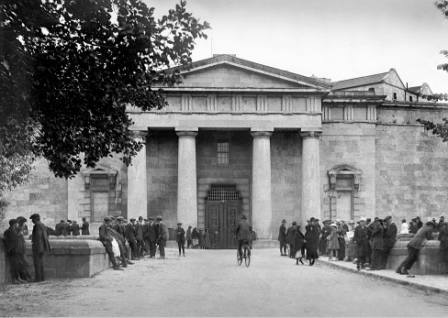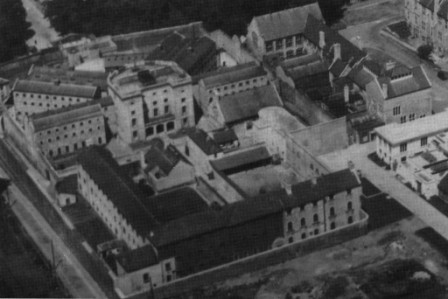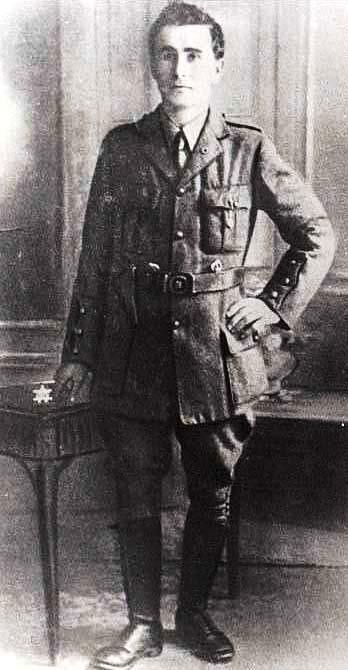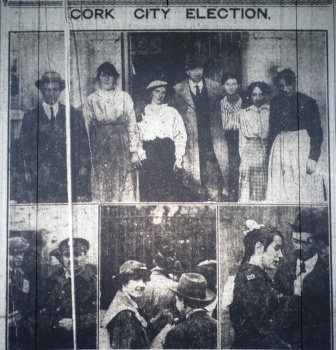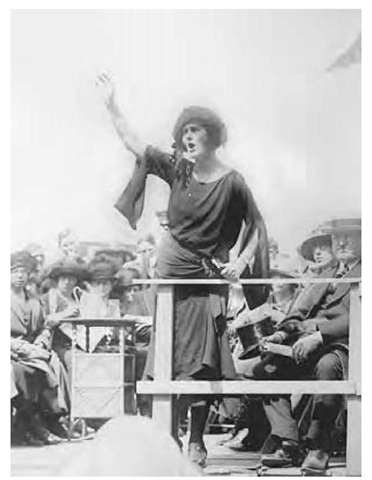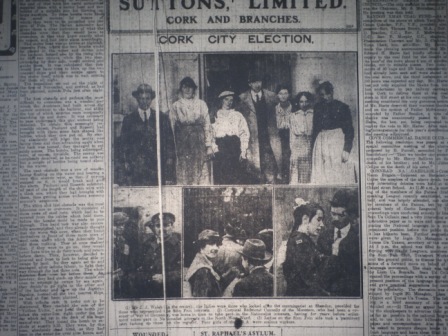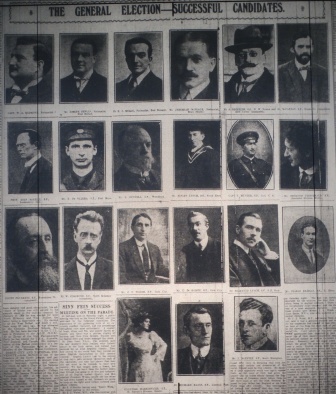-
A Sin Of The Rich
January 1st, 1918Even at the height of the First World War and the continuing tensions at home between the Irish people and the Crown forces, the privileged few would host these opulent affairs. This image was taken on the 1st January 1918 at showing the South Union Hunt ringing in the New Year in the Douglas area of the city, gathering by the old Finger Post.
-
A Cork Casualty
January 2nd, 1918On the 2nd of January 1918, Lance-Corporal W.C Egan of the Royal Irish Guard, aged 20 years, was reported killed in action by ‘The Cork Examiner’ . His death actually occured on the 27th of November 1917 . He was the first of many Irish men killed serving the Crown forces that year but as time went on the death notices soon filled with those of the RIC, Crown Forces stationed in Ireland and Irish Volunteers. Soon people fighting at home forgot about those fighting the Great War and in some cases these young men would be considered a disgrace by others for not fighting the war at home.
Lance-Corporal W.C Egan was wounded twice during his service at the Somme. He was the youngest son, at 20 years of age, of Mr W.J. Egan who resided at Pram house, Grattan Street, Cork City.
-The Somme
-The Trenches
-
Children Helping The Poor
January 4th, 1918This picture is a scene from the play “Ard O’Neill” and it is representing the home-coming of the Great Chieftain, The Great O’Neill, after ‘The Battle of the Yellow Ford’. This play, as well as another piece called “Losagan”, was to be performed at the Opera House by a cast of three hundred and fifty students. The students were from the local Christian schools, North Monastery Cork. Proceeds were devoted to the aid of the ‘Poor Children’s Milk Fund’.
-
Children's Reforestation Scheme
January 15th, 1918On Tuesday the 15th of January in 1918, the female students of the Whitechurch National School began planting trees in an effort to encourage reforestation in their local area. The children planted over 600 trees, despite a heavy snow storm making the process a struggle. The scheme was being overseen by the Cork Committee of Agriculture and the manager of the schools, Rev. M. Canon.
Cork Examiner, 17 January 1918, page 5
-
Interesting Military Ceremony
February 6th, 1918On Thursday the 6th of February, Grand Parade was a host to an unusual event. Crown Forces Troops held a ceremony to honour Lieutenant Edward Alexander Stoker who died fighting with the Royal Irish Regiment in World War I. The Military Cross was presented to his mother, Mrs. E. B. Stoker, and his family by Major-General Doran GCB (The Most Honourable Order of the Bath). Some would argue that the ceremony was propaganda for the Crown Forces. Conscription was about to be declared in Ireland.
-Lieutenant Stoker
Lieutenant Edward Alexander Stoker belonged to the Special Reserve of the Royal Irish Regiment. He was awarded the Military Cross due to his service in November the 14th, 1916 and again on the 9th of September 1917. On the 14th of November in 1916, Lieutenant Stoker led a group of soldiers and captured some enemy snipers, and during a counter attack he led more soldiers across an open area to a threatened flank under heavy fire from the enemy troops. Once again, on the 9th of September 1917, Lieutenant Stoker distinguished himself in battle but unfortunately he was wounded in the course of his operation and subsequently died of his wounds on the 12th of September 1917.
Cork Examiner, 12 February 1918, page 3
-
Funeral Of Mr. Walsh
March 5th, 1918On Tuesday the 5th of March St Patrick's Street in Cork City witnessed a large procession of Irish Volunteers honouring the late Mr Thomas Walsh. The funeral took place at 3pm from the Cathedral of St Mary and St Anne to St. Finbarr’s Cemetery, located at Glasheen Rd, Togher, Cork City. It is noted that the cemetery has its own republican plot which is marked by a massive stone cross by the main entrance. The funeral procession took a set route, which was to leave the Cathedral via-John Redmond Street and progress along Camden Quay, St Patrick's Bridge, St Patrick's Street, Grand Parade (as seen in the image above) and finally Great George's Street (Oliver Plunkett Street) to the cemetery. In the procession there were members of the Irish Volunteers, Irish Volunteers Pipers’ Band, Cuman na mBan, Irish Citizen Army, Girls Scouts, Fianna Boys Scouts, Irish Citizen Army Boys Scouts, Queenstown Irish Volunteers and many civilians. Mr. Walsh’s coffin was covered with the Sinn Féin Flag and was surrounded by wreaths.
-Frongoch InternmentCamp
Mr. Walsh lived in Cork for a large part of his life before moving to Dublin a few years before his death. He took part in the Easter rising of 1916 and as a result he was imprisoned in Frongoch internment camp, located in Merionethshir, Wales. Later he was again imprisoned due to a connection with rioting in Dublin. Unfortunately Mr. Walsh contracted pneumonia in his later years while he was in Arklow working as a free man. In honour of his service the Irish Volunteers fired a three volley salute at his graveside and all those present took a knee while a decade of the Rosary was read out.
Cork Examiner, 6 March 1918, page 3
-
Eyeries RIC Barracks Raid
March 17th, 1918On the night of Sunday, the 17th of March 1918, at around eight p.m. there was an armed raid on the local RIC (Royal Irish Constabulary) Barracks in the village of Eyeries located a few miles from Castletown Berehaven. The raid was carried out by five armed men who entered the premises and subdued the only RIC constable on duty. The men were able to make off with four Carbine rifles, a quantity of ammunition and other small articles of equipment. The men then left the village with what they had liberated from the RIC Barracks without any shots fired or injury to the constable on duty. Despite a large police search of the area, the RIC were unable to locate the men or the weapons.
The volunteers involved in the assault on the RIC (Royal Irish Constabulary) barracks in Eyeries were: Joe Foley, Sean Driscoll, Con Dwyer, Peter O’Neill and Christy O’Connell. They left their homes disguised in large coats in order to conceal the weapons they were carrying. Four of the men waited in a boreen beside the building while Christy O’Connell moved to the front door to confront the lone Constable. O'Connell's witness statement reads: “…I whipped out my little gun and ordered, “Hands up”. In return, he swiftly pointed his right hand at me, and I pulled twice on the trigger. There were two dull clicks– my two rounds were duds. There was no shot from his side either – it was his finger he was pointing at me, thinking I would mistake it for a gun in the dark. Then he backed in quickly to slam the door, and I hurled myself at him with full force. There was a step down inside, and the force of the impact sent him reeling into the hallway. Again, I ordered, “Hands up”, and this time he obeyed. It was with mixed feelings I stood there in the hall, holding up this giant R.I.C. man. I can still picture him– fair complexion, broad shoulders and deep chest, a man of splendid physique– and the light from the table-lamp in the dayroom shining through the open door. I was thrilled at having taken this symbol of British imperialism, as it were, by assault, anxious that my comrades should come to my assistance and fearful every moment of getting a clatter….”-Bureau of Military History
-Eyeries RIC Barracks
The following are the facts dictated to ‘The Cork Constitution’ by the RIC in relation to the events of that night: “On Sunday evening, after tea, Sergeant Murnane and two constables proceeded on patrol duty, leaving another constable in charge, as guard. At eight o’clock, when the guard was the only occupant of the barracks, a knock came to the door, and on the constable opening it, his dismay may be imagined to see five armed and disguised men outside, who immediately called upon him to surrender, pointing their rifles at his head at the same time. Considering discretion the better part of valour, in the extraordinary circumstances, the constable surrendered, and the men entered the dayroom, and proceeded to search for arms and ammunition, with apparently little concern. Four carbines were hanging on the dayroom wall, and these the raiders quickly appropriated, with, it is stated, a quantity of ammunition and some accoutrements. While two of the party were making the search, the others kept the guard under strict submission, threatening to shoot him if he offered the least resistance. Having satisfied their requirements, the raiders decamped.” –The Cork Constitution.
Cork Constitution, 20 March 1918, page 5
-
Cork Against Conscription
Monday 15th April, 1918On Monday the 15th of April 1918, a large crowed gathered in front of a wooden platform on the Grand Parade for an anti-conscription bill protest. The British Army had lost ninety-eight square miles of the front line in only one day, which penetrated as deep as five miles into their main lines during the German Spring Offensive. Even though Ireland was under martial law since August 1914, conscription was not brought in until the Military Service Bill that now would extend conscription to Ireland.
Cork Examiner, 17 April 1918, page 2
-
Conscription Comes To Ireland
Thursday 18th April, 1918On Thursday 18th April 1918, The Conscription Bill became law. It is important to note that even though it was declared law on the 18th of April, it still was not allowed to come into effect till fourteen days after an order in Council had been laid on the table in Parliament. Even though many Irish men had already volunteered to fight in the war the British still felt the necessity of the Conscription bill in order to conscript more that 150,000 Irish men to the War. They did not realise or even consider the effect it would have on uniting the Irish people and their leaders in opposing the bill, as well as over all British governmental interference. The British government hoped that the Irish people would take the deal of Home Rule once the Conscription Bill was allowed to take effect.
-Anti-Conscription Pledge
Cork Examiner, 19 April 1918, page 5
-
Anti-Conscription General Strike
April 23rd, 1918On Tuesday the 23rd of April 1918 Ireland hosted a national Anti-Conscription general strike which saw the cogs of industry in Ireland come to a halt for 24 hours. This was witnessed in Cork City as thousands of Cork's labour force assembled on Grand Parade in protest against the Conscription Act to Ireland. The protest was lead by the President of the Cork United Trades, Very Rev. Father Thomas, whose speech evoked extraordinary enthusiasm.
-Newspaper Summary
During this 24 hour work stoppage there was not one shop opened in the city of Cork, no trains in or out of the City and no work on the wharves. Not even the local licenced premises opened in the City as it was a day of protest. Thousands of Cork's labour force stood respectfully on Grand Parade till 10:30pm when most returned to their homes. The women’s protest was held at Cork City Hall and was considered the largest protest gathering by women ever seen in Cork to that date. It is estimated that twenty to thirty thousand protesters took part in Cork City alone.
Cork Examiner, 24 April 1918, page 3
-
Beal a’Ghleanna Ambush
July 7th, 1918On the night of Sunday the 7th of July 1918 an armed ambush on two Royal Irish Constabulary personnel took place at around 8pm. This ambush was the first attack on foreign forces on Irish soil since the Easter Rising of 1916. The monument at the site of the ambush was unveiled by An Taoiseach, Jack Lynch 17- 03 -1970”.
-Map Data 2017 Google Maps
The ambush took place on a small mountain road between Ballingeary, located to the south, and Ballyvourney, located to the north, which are about 18 kilometres apart. The area of the ambush is known locally as ‘Beal a Ghleanna’ or ‘The Mouth of the Glen’ due to there being a steep slope leading into a glen off the mountain road on the left-hand side as you travel in the direction of Ballingeary. At this location both Constable Butler and Constable Bennett of the Royal Irish Constabulary (RIC) were making their way back from Ballyvourney after helping to prevent a Feis taking place at Coolea close by. They were travelling in a horse-drawn sidecar when a party of seven volunteers ambushed and searched them at gun point. Dan Mac Sweeney and Liam Twomey were the first to draw their revolvers on the two Constables leading to Constable Butler reaching for his rifle, and in doing so, received a non-fatal bullet wound to the neck. Constable Bennett was not injured in the exchange or the course of the ambush. Once the Constables were subdued, their side-car was pushed into the glen and both rifle and ammunition were taken.
Jamie Moynihan recalls the events that took place in ‘Memoirs of an Old Warrior: Jamie Moynihan’s Fight for Irish Freedom 1916-1923. Mercier Press: Cork, 93-45, Ó hÉalaithe Dónal (ed.) 2014. “...I was to be the first person on the road, to catch and hold the horse… As soon as the grey horse and side-car came into line, I jumped out onto the road and caught the horse by the head. [Johnny] Lynch jumped after me and caught the older of the two policemen, who was a powerfully strong and well-built man. Lynch and the policeman were struggling fiercely and eventually the RIC man pulled the mask off Lynch’s face. Dan Thady and Liam Twomey came out of a little gap on the southern side. One of them fired a shot and hit the young policeman through the neck. At this stage, Johnny Lynch was getting the better of the RIC man and pulled him off the sidecar and on the road, rifle, cushion and all. I picked up Lynch’s double-barrelled shot gun, which was loaded and thrown on the road, I gave the RIC man a belt of it across the shoulders and the backside, and he collapsed in a heap on the road…”
The volunteers involved that day were Sean Lynch, Tadhg Twomey, Liam Twomey, James Moynihan, Jeremiah O'Shea, Dan Tady Sweeney and Cornelius O'Reilly.
-
Donnchadha MacNeilus Rescue
November 11th, 1918The rescue of Donnchadha MacNeilus was one of the earliest and most successful rescues during the early part of the War for Independence. With only six days of planning, organised by Brigade Commandant Sean O’Hegarty, Volunteers managed a daring rescue without the aid of anyone inside the prison. MacNeilus had shot and wounded the arresting head constable, which would result in his execution if the Constable died. On the Wednesday before the rescue, Sean O’Hegarty, visited MacNeilus and slipped him a note detailing the rescue plan.
-Cork Mens Prison
On Monday the 11th of November at around 3.30pm two Volunteers asked to see MacNeilus. They were taken in the main gates to the visitor waiting room, which was located between the main gates and one large wrought-iron gate. After around five minutes had past two more Volunteers entered the prison asking to visit another prisoner, and after a further five minutes two more Volunteers did the same. At this point there were six Volunteers inside the waiting room while others took position outside.
As the first two Volunteers went to the main visitors' room, the Volunteers outside cut the phone lines and detained anyone who approached the jail. When the warder unlocked the visitors' gate after the first two volunteers finished their visit, they subdued the warder and released MacNeilus. Handing MacNeilus a revolver, the men made their way calmly back to the visitors' waiting room where the four other Volunteers had subdued the warder on duty. When the men left the prison there was a little confusion to the rest of the plan. MacNeilus took a bicycle from outside the prison and made his escape, only to find himself alone and lost. He returned to an area near the prison and was met by two Volunteers who took him to safety.
-Donnchadha MacNeilus
Donnchadha MacNeilus was originally from Malinbeg, Glencolumbkille, Co Donegal and moved to Cork City where he worked at Haulbowline dockyards. He was a qualified electrical engineer. He was also armourer for the companies in Cork city, as well as being a Captain of the cyclist company attached to Brigade headquarters, which lead him to be always in the possession of fire arms for storage and repair. He swore to protect the weapons with his life and lived up to that promise the day the home he was staying was raided, and he shot the head Constable.
Donnchadha MacNeilus took part in every aspect of Volunteer life and in later years passed away in 1954 and was buried with full military honours.
-
Irish General Election
December 14th, 1918On Saturday the 14th of December 1918, Ireland hosted its first General Election in eight years. Even though it was considered part of the English General Election, it was seen as a key moment in modern Irish history and a major step in declaring Ireland's Independence. The Sinn Féin party had significant support over the National Irish Parliamentary Party (IPP) who dominated Irish politics since the 1880’s. This support for Sinn Féin can be contributed to the English government enforcing conscription in Ireland in the later months of World War 1, a decision which infuriated and increased the number of Irish people united against English rule. Another factor was that the electorate had increased due to a new Act allowing more Irish people the right to vote.
-Countess Markievicz
The passing of the ‘Representation of the People Act of 1918’ earlier in 1918 increased the Irish electorate from 700,000 to nearly 2 million Irish voters. The Act allowed all Irish women who were aged 30 years and over and home owners, the right to vote. It also extended the right to vote to all men over twenty years old from all classes. For the first time, a woman, Countess Markievicz, ran in the elections for a position in Parliament.
Newspaper cite:Cork Examiner, 18 December 1918, page 3
-
Irish General Election Results
December 28th, 1918On Saturday the 28th of December 1918 the results of the first General Election for eight years was announced. Out of 105 seats Sinn Féin secured 73 seats of which 25 were returned as unopposed, 17 of those seats being from Munster. This was a landslide win for Sinn Féin with a total of 476,087 votes. The first woman to be elected to the British House Of Commons was Countess Markievicz, who did not take her seat with other Sinn Féin elected members.
The following are the names of the candidates from Munster;
Cork City:James Walsh 1st Preference Votes = 20,801
Liam De Roiste 1st Preference Votes = 20,506
Cork East:David Kent 1st Preference Votes = Unopposed
Cork Midlands:Terence Mac Swiney 1st Preference Votes = Unopposed
Cork North:Patrick O'Keeffe 1st Preference Votes = Unopposed
Cork North East:Thomas Hunter 1st Preference Votes = Unopposed
Cork South:Michael Collins 1st Preference Votes = Unopposed
Cork South East:Diarmuid Lynch 1st Preference Votes = Unopposed
Cork West:Seán Hayes 1st Preference Votes = Unopposed
After the elections all Sinn Féin elected members refused to attend the British Parliament in Westminster, London. They formed a parliament in Dublin instead known as the First Dáil (Assembly) which had its first meeting on the 21st of January 1919 in the round room of the Mansion House, the residence of the Lord Mayor of Dublin.
